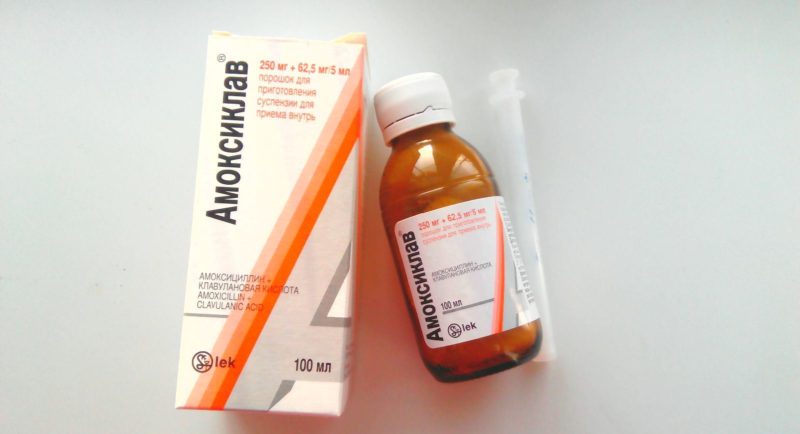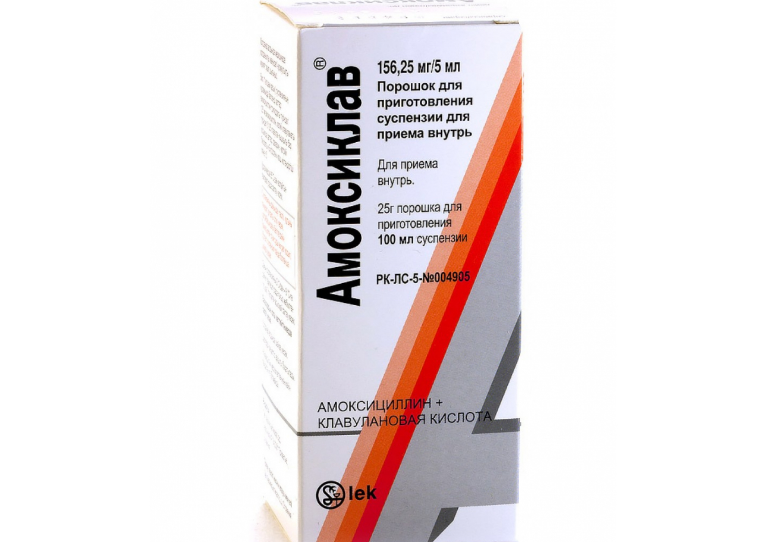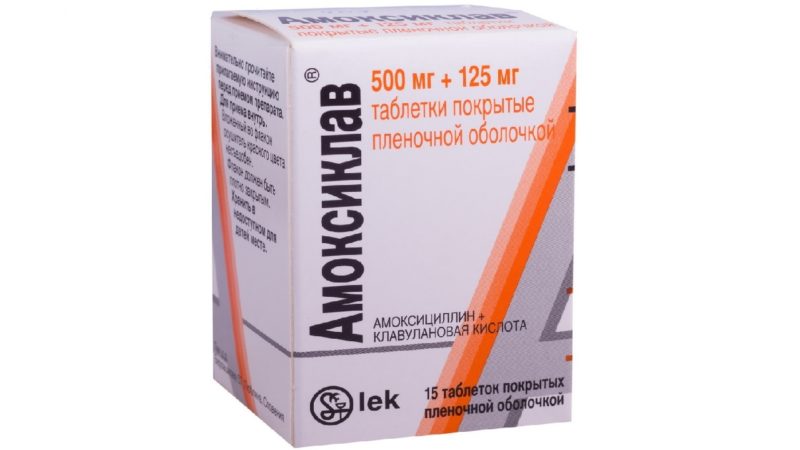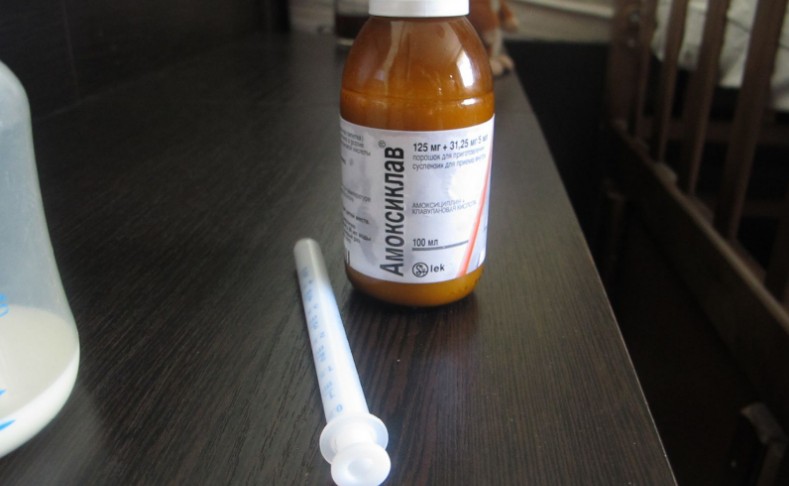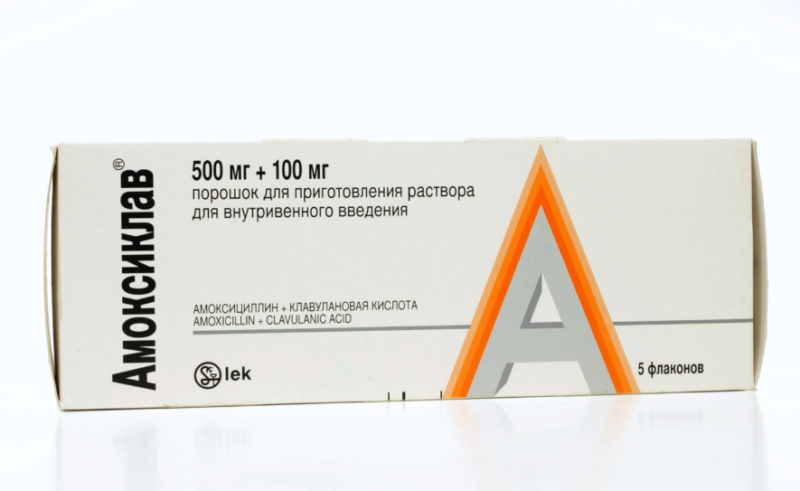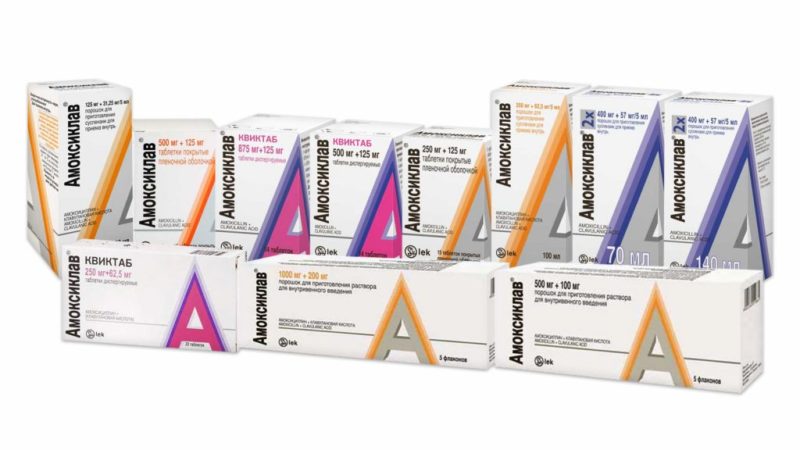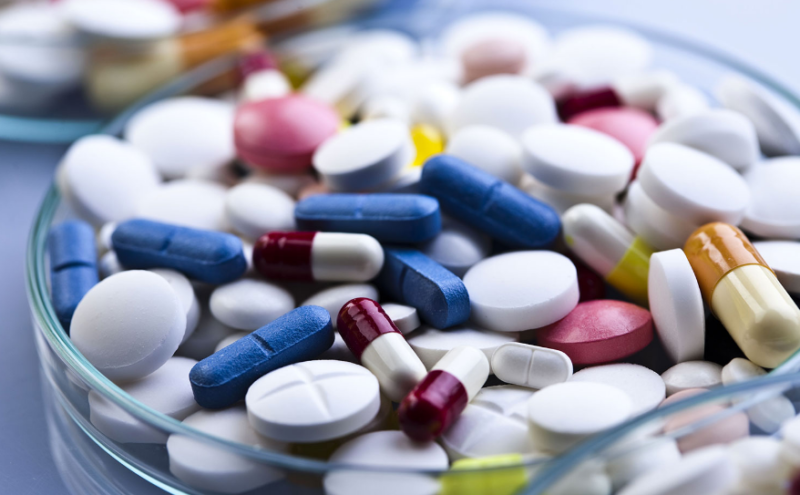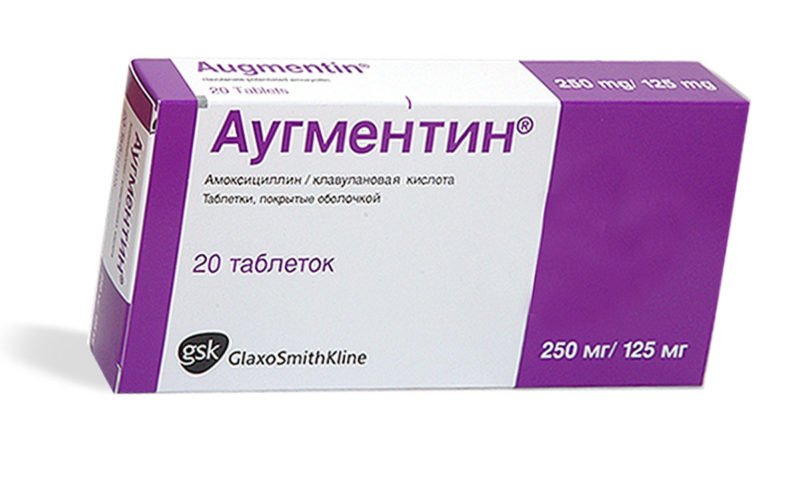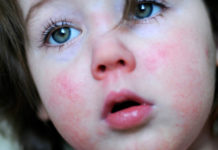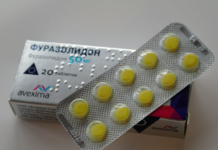Infectious diseases are extremely dangerous for children, therefore, they require immediate antibiotic therapy. It is important to choose the most effective drug, but with the minimum risk of side effects. The most popular "Amoxiclav" for children, but the use of this tool requires caution and constant monitoring by a specialist.
Material Content:
Release forms and composition of the antibiotic
Amoxiclav is presented in pharmacy shelves in several dosage forms:
- in powder (dilution gives a suspension (syrup));
- in powder (injection solution is prepared by dilution);
- in regular tablets.
In the first case, the product looks like a powder, white, sometimes with barely noticeable yellowness. It contains the antibiotic amoxicillin in combination with clavulanic acid. Among the additional components, other substances responsible for the form, taste and preservation of the pharmaceutical product.
In injection powders, the antibiotic is represented by sodium salt, and the potassium salt is its complementary component.
The tablets look like small orageous tablets, the color is pure white or with a slight grayish / yellowish tinge. The composition includes the same active constituents. Auxiliary components: talc, macrogol, silicon dioxide, diethyl phthalate, cellulose, titanium dioxide, crospovidone, magnesium stearate, hypromellose, ethyl cellulose.
Pharmacological properties and indications for use
Amoxicillin is a penicillin-related antibiotic. Effective for the treatment of infections caused by gram-negative and gram-positive bacteria.
But its significant drawback was the inability to act on the organisms that produce beta-lactamase. To neutralize this effect, clavulanic acid was included in the composition, which previously blocks beta-lactamase substances and allows amoxicillin to target the microbe.
The principle of action of the agent under discussion is the inhibition (blocking) of transpeptidase. This is an enzyme that is necessary for the formation of bacterial cell walls. When it spreads through the body, the microbe divides, but under the influence of amoxicillin, the cell is destroyed.
- The main components easily dissolve in water, without losing their properties, are rapidly absorbed in the stomach. The optimal intake time is before meals.
- The maximum concentration is observed already an hour after taking the drug. The percentage of binding to blood proteins is about 30%.
- Both substances are processed in the liver, but the excretory routes are different: the remnants of clavulanic acid can be found in exhaled air, urine (the highest percentage) and feces, amoxicillin is most actively excreted due to the activity of the kidneys.
The drug is used to treat various diseases caused by microbial pathogens:
- respiratory diseases (otitis media, pharyngitis, tonsillitis, sinusitis, pneumonia, sinusitis and other inflammatory processes in the sinuses of different locations);
- disorders in the genitourinary system (pyelitis, urethritis, cystitis, nephritis, gonorrhea);
- GIT disorders (cholecystitis, cholangitis, dysentery, typhoid fever);
- skin lesions (leptospirosis, impetigo, erysipelas);
- other diseases (meningitis, endocarditis, sepsis).
Age restrictions on admission
The official instructions for use indicate that Amoxiclav is permitted for children from 3 years. But in modern medical practice, the drug is also actively used in the treatment of bacterial diseases in children at an earlier age.
Since there is an increased risk of side effects, treatment should be carried out only under the strict supervision of the attending physician.
Self-medication using amoxicillin at any age is prohibited!
Instructions and dosage for children
Dosages of Amoxiclav for children in the official instructions and as prescribed by the doctor may vary: for each disease and certain age groups of children, specific volumes of the active substance are needed. During treatment, indicators may change, for example, with the ineffectiveness of treatment with a certain dose of the drug.
Suspension Amoxiclav
This form of release is not presented on the market, there are only powders for the preparation of various solutions. For example, a lyophilisate to create an injection solution.
It can be found in pharmacies with the mass of the main substance:
- 600 mg, where 500 mg is amoxicillin, 100 mg is clavulanic acid;
- and with a mass of 1200 mg (1000 mg + 200 mg, respectively).
To prepare the solution, dilute the contents of the vial in 10 ml of water, if this is the first described release form of the lyophilisate (500 + 100), or in 20 ml of water, if the second (1000 + 200).
The drug is administered at a low speed for 30 to 40 minutes in a jet or drip. Do not use the product 20 minutes after preparation. Dosages are given below based on the patient's age.
| Age | Single dose (mg) | Interval between administration procedures (hours) |
|---|---|---|
| Up to 3 months (body weight - less than 4 kg) | 30 per 1 kg of weight | 12 |
| Up to 3 months (body weight - more than 4 kg) | 8 | |
| 3 months - 12 years | 8 (for severe diseases - 6) | |
| From 12 years | 1200 | 8 (for severe diseases - 6) |
Typically, treatment lasts from 5 days to 2 weeks.
Therapy of children with renal dysfunction requires dose adjustment, which is carried out under the strict supervision of a physician.
Powder for suspension
In this form, the pharmaceutical product under discussion exists with different contents of the main components:
- 125 mg + 31.25 / 5 ml syrup;
- 250 mg + 62.5 / 5 ml;
- 500 mg + 125 mg / 5 ml;
- 875 mg + 125 mg / 5 ml.
To prepare the suspension, you will need to add purified water to the powder in two approaches:
- Shake the vial first, find the label that determines the required level of added fluid.
- Pour in water so that it reaches 2/3 to the mark, screw on the cap until it stops, shake.
- Add the remaining amount of liquid, close, shake.
Before each dose, it is necessary to agitate the suspension to evenly distribute the active substance.
Single doses are given in the table. For easy measurement of syrup volumes, a special pipette comes with the drug. The smallest division is 0.1 ml.
| Weight | The mass of active components (mg) | The required volume of suspension (ml) | The number of receptions per day |
|---|---|---|---|
| Up to 40 kg | 25/75 for severe diseases | 0.4 / 1.2 for severe diseases | 3 |
| More than 40 kg | 75 | 10 ml | 3 |
Children under 2 months should not be given more than 50 mg of the active complex (0.8 ml of suspension) per day.
When treating patients from 12 years of age, the greatest amount of the substance per day should not exceed 3 g of the complex “amoxicillin and clavulanic acid”.
Pills
It can be found in pharmacies with different contents of antibiotic and concomitant substances: 250 mg +125 mg, 500 mg + 125 mg.
Tablets are not given to children who have not reached the age of 12 and have a body weight below 40 kg.
For children from 12 years old and adults, the dose is 375 mg of the active substance (250 mg + 125 mg Amoxiclav tablets are preferred) or 625 mg if a severe or complicated infection is observed.
It is better to take before meals with a glass of liquid.
Drug interaction
Antibiotic Amoxiclav is characterized by increased activity and therefore does not exclude negative reactions when combined with other drugs.
| Means | Form of interaction |
|---|---|
| Rifampicin | Antagonistic reaction (the antibacterial effect of two substances decreases) |
| Oral contraceptives | Decrease their effectiveness |
| Indirect anticoagulants | Clotting |
| Allopurinol | High risk of exanthema (rash on the body) |
| "Metoctrexate" | Increase its toxic properties |
| Macrolides, tetracyclic antibiotics | Decreased Amoxicillin Effectiveness |
Contraindications, side effects and overdose
Contraindications include only the presence of allergic reactions to substances from the penicillin series and clavulanic acid, as well as significant liver dysfunction.
Special care should be taken in drug-based therapy for people who have pseudomembranous colitis (which develops after taking antibiotics) with a complex of disorders in the liver.
You should not use the mother’s drug while breastfeeding - after a while, the child may experience certain adverse reactions characteristic of the drug, but the therapeutic effect is minimal.
Possible side effects include:
- gastrointestinal tract disorders, lack of appetite, stomatitis, changes in taste perception, impaired liver function, including the development of jaundice, hepatitis;
- in patients with a weakened digestive system — pseudomembranous colitis;
- sleep disturbances, headaches, disorientation, sudden changes in mood, irritability, dizziness;
- standard manifestations of allergies: rash, redness on the skin, which is accompanied by itching, less often - exudative erythema, anaphylactic shock, angioedema, very rarely - Stevens-Jones syndrome;
- extremely rarely - candidiasis, superinfection.
In case of an overdose, fatal cases have not yet been observed, only disturbances in the digestive tract, insomnia, and anxiety. Cases of seizures such as epileptic were extremely rare.
The list of procedures for eliminating the consequences of an overdose include gastric lavage, intake of activated charcoal. The negative consequences of taking an increased dose in medical practice are removed through hemodialysis, but such actions should be carried out under the strict supervision of a doctor.
Amoxiclav analogues for children
In fact, almost all antibiotics based on amoxicillin become analogues of Amoxiclav.
According to doctors, imported drugs are often better perceived by the body of children, but domestic manufacturers produce cheaper options.
Among the most popular antibiotic options that are based on the complex “amoxicillin + clavulanic acid”, there are:
- “Augmentin” - almost completely repeats the composition of “Amoxiclav”, has similar side effects, indications, contraindications;
- "Flemoxin Solutab" - is prescribed only to children from a year old, ineffective against organisms that produce beta-lactamase;
- "Amoxicillin" - approved for use by children from 2 years of age, has more side effects, does not contain clavulanic acid in the composition.
Other analogues of Amoxiclav may include drugs of other groups, for example, cephalosporins:
- "Aksetil" - a light antibiotic that is prescribed for uncomplicated diseases of the lungs and urinary tract, shown from birth;
- "Zinacef" - requires a clear dose adjustment depending on body weight, constant monitoring of the condition of the kidneys is necessary;
- "Aksetil" - is prescribed from birth, but is indicated only for mild forms of bacterial diseases, is ineffective against the rest;
- "Suprax" - is approved for the treatment of children from 6 months, requires monitoring of renal function;
- "Ceftriaxone" - is administered only intramuscularly or intravenously, shown from birth.
In more severe diseases, the doctor may prescribe an antibiotic from the macrolide group:
- “Chemomycin” - based on azithromycin, shown from 6 months, requires constant monitoring of the child’s health;
- "Sumamed" - a new generation antibiotic, is prescribed mainly for complex diseases of the respiratory system or skin, is not recommended for children under 3 years old;
- “Klacid” - indications and age restrictions coincide with those of “Sumamed”.
It is important not to be based on your own discretion when choosing an analogue. There are many factors that determine the form and type of drug that is most effective in a given case. The right tool can only be selected by a qualified specialist.
"Amoxiclav" is an effective antibiotic, which is prescribed for various diseases of a bacterial nature. When taking it, it is important to remember that this is an extremely active tool that has a significant list of side effects. Special care should be taken with antibiotic treatment in children.


